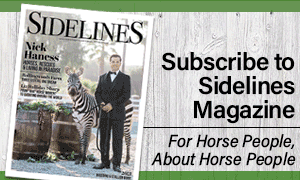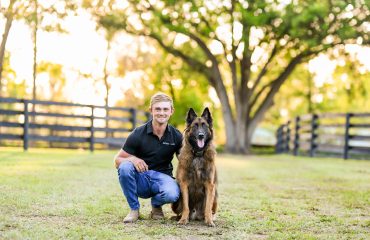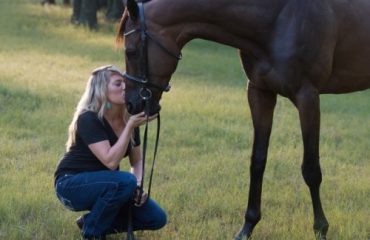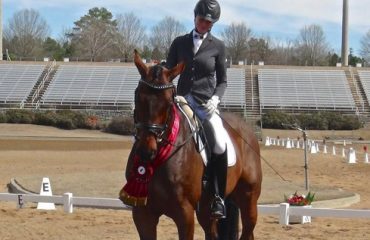By Lauren R. Giannini
It’s always horses for Beth Perkins. They’re the driving force on which she thrives — her work, her play, her passion, and her earliest memories.
Beth started riding before she could walk. Horses are in her genes, thanks to Essie and Read Perkins, who bred, trained and sold event horses, competed at the upper levels, and ran horse trials at their Huntington Farm in Vermont.
Beth and younger sister Bea (Mrs. Derek DiGrazia) ate, slept and breathed horses. They became two of the youngest Pony Club riders to achieve the coveted USPC A-rating. Beth’s defining influences included her parents, Swedish show jumper Lars Sederholm, the late legendary U.S. eventing coach Jack LeGoff (1970s–mid-’80s) and Olympic show jumpers George Morris and Anne Kursinski.
“I was very fortunate all my life to be exposed to some of the very best instructors and they all had one thing in common — a disciplined, thoughtful approach,” said Beth. “It’s called ‘classical’ riding, but what that really means is that you have a system that makes sense to the horse because you also have to be adaptable. The product of a disciplined, structured approach to riding is feel, and feel is what it’s all about. As a rider, teacher, trainer, you want to know how a horse feels when he’s working well underneath you, in balance and engaged. It’s feel that helps you to teach, train and show the horse, step by step; how to go forward in balance.”
Eventing Career
Beth’s eventing career began early. After high school graduation, she went to England to be a working student with Lars Sederholm and started riding Furtive, an Australian horse, bought for a song by Beth’s father following the 1972 Munich Olympics. She competed in British horse trials and learned about being a horseman from Lars. “I couldn’t bear to part with him when it was time to come home, so Furtive came with me,” said Beth. “We did Ledyard that fall and got invited to a training session with Jack LeGoff and got asked to stay on after that. Furtive was wonderfully honest cross-country and helped me get experience in the upper levels. Jack really helped with his dressage.”
Beth was training alongside Bruce Davidson, Denny Emerson, Mike Plumb, Don Sachey and Caroline Treviranus, to name a few. She was only 18 when she placed sixth individually with Furtive in the 1974 World Games, held at Burghley in England. The next year in Mexico for the Pan American Games, the duo finished fifth individually and contributed to the U.S. Three-Day team’s gold medal. In 1976, she was short-listed for the Montreal Olympics. Reality beckoned, and she left the team, later returning to serve on the Three-Day Selection Committee for the 1996 Atlanta Olympics.
Real life meant attending college intermittently, working at various horse-related jobs and helping at home when she could, but horses always beckoned. Beth galloped racehorses, rode in point-to-points, and competed a few event horses. She was home as much as possible while her mother was dying of breast cancer. Then, a few years later, she helped her father during the illness that led to his demise. Beth and Bea ended up selling the horses and the farm. Recalling that her father had always told her she had a good brain, Beth earned a B.A. in English and M.F.A. in creative writing. Best of all, she loved to teach, train, bring along event horses to sell, and compete, which is what she did for the next decade or so.
Health Crisis
In September 2000, life as Beth knew it came to a halt. Because of her mother, she’d been diligent about getting annual mammograms. Discovering a lump during a routine self-examination, Beth insisted on a biopsy. It was malignant. At the time, she lived in California, ran a successful business, had been through a divorce and remarried. Beth and Mick Doyle were busy with their combined family of four children, as well as with their work. Beth was riding eight to 10 horses a day, teaching six days a week and competing several times a month. She faced a mastectomy, months of chemo and possibly a year or more before she’d get back her strength.
“What helped was knowing that people cared so much about me and my well being and I’ll always be grateful to those people who were there for me during the time of my diagnosis,” said Beth. “My sister Bea was there for me — we had lived through our mother’s death from breast cancer — and my husband, Mick, helped me to stay strong. I was so worried about not being able to work — I came to realize that stress really weakens your immune system — but even that was taken care of. I still feel very blessed and fortunate for everyone’s support.”
Her family and friends raised money so that Beth didn’t have to fret about not being able to contribute her fair share to support her family. She fussed, but went after her recovery with the same single-mindedness she utilized to train a challenging horse. She did an acupuncture regimen that worked with the chemo treatments. She followed the acupuncturist’s advice about resting, walking, drinking water and, after chemo ended, taking supplements. She ate organic — lots of raw food, juices, broccoli, flax, almost a prototype of the Paleo Diet — and cut back on alcohol and junk (sugar feeds cancer). She learned to meditate.
“I’ve started to practice that again,” said Beth. “It helped me with the mind-body connection. Sometimes not fighting against oneself is difficult. It means not giving in to impulses and remembering that I truly have to take care of myself. It takes planning and sticking with a regimen. I tried to find out everything I could about cancer and healing approaches from all over the world and adapted some of them into the way I live. I thought about why I might have gotten the disease. Stress was a factor. I remember being told that I had to fight the disease and not give in.”
Helped By a Horse
In retrospect, the support and love of family and friends were essential, although a horse was instrumental in motivating Beth to focus on the goal of both of them getting well. “It was Don’t Dali,” she said. “I bought him on my way home from my final round of chemotherapy with funds raised by a group of students and friends who wanted me to be able to take time off from work to recover from all the treatments.
“My sister Bea was with me in the car,” continued Beth. “We stopped at a farm in Petaluma where I lived at the time to see several offspring of a Thoroughbred stallion, imported from Ireland, that was standing in Fresno. They made good sport horses, nice big types with heavy bone, but they just weren’t fast enough on the track. Bea bought his sister and sold her. Don’t Dali and I spent many hours walking, me on foot leading him, because he was recovering from a soft tissue injury and I wanted to get my strength back.”
Foaled in 1995, Don’t Dali, by Valdali (IRE) out of Now You Don’t, had seriously good, old bloodlines including a double nick on his dam’s side to Native Dancer, and Mill Reef (a champion stakes winner in England) as his topline grandsire. Beth described the bay gelding with two hind socks as a tough, challenging horse with a sweet nature.
“Don’t Dali — I called him Val — gave me something to strive toward,” said Beth. “My family is great and I couldn’t imagine going through cancer and treatment without their love and support, but having a horse of my own again made me want to get strong and it gave my riding career a second chance.”
Beth trained and competed Don’t Dali up to Intermediate. In June 2005 at Bromont CCI**, they placed third on their dressage score. In July, Beth sold Don’t Dali to Will Faudree, who took him to the Advanced level. Val’s departure left a horse-shaped hole in her heart, but selling was what her family did, and finding a new prospect helped fill the void. Beth was in Massachusetts to teach a cross-country clinic and ended up with Val’s half-brother.
Cynthia Barclay arrived at the clinic, armed with a photo of a dark bay, 17.1-hand, off-the-track Thoroughbred gelding, registered as Mr. Glaisyer, also by Valdali, but out of a different mare, Fittingly. Beth tried him for two weeks, liked him, and Cynthia put “Sal Dali” into full training at Hobby Horse Farm near Tryon, North Carolina, where Beth and Mick had moved their family in 2002.
Sal was a very green jumper, but game. He really tried, had the movement on the flat, the jump and the “get up and go” to be a successful event horse. His biggest issue was relaxing, especially for the dressage test.
Goals for Riding and for Life
In 2012, Beth and Sal debuted at Rolex Kentucky, the premier CCI**** this side of the Atlantic. They ran at Rolex again in 2013. Both years, they achieved similar results, but there was substantial improvement the second time around. Their dressage test placed them close to the bottom. They jumped the daunting cross-country track clear, albeit with time faults. They had jump and time faults in show jumping, but in 2013 toppled only three rails. They completed both times — an achievement and, at a world-class event like Rolex, in itself a victory.
Nowadays, Sal and GHF Sterling Spirit, an Advanced horse owned by Ann Getchell, enjoy retirement at Hobby Horse Farm. Val (Don’t Dali) had soundness issues and returned to Beth to enjoy an easy life until he crossed the rainbow bridge in May. Beth hasn’t slowed down per se, but she’s much smarter about how she takes each day. With 14 years of remission, she’s full of “get up and go” — a trait she values in event horses. She loves HHF Harry, her 4-year-old, bred by the late Dr. Mary Alice Brown.
In June, Harry aced his eventing career debut, with Beth in the irons, of course, at Chattahoochee Hills, in Georgia, in Open Beginner Novice. They led all the way to win on their dressage score of 27.50 in a field of 17. So far, Harry has checked off all the boxes as a serious event prospect, plus Beth totally enjoys riding him.
Horses, family, nutrition and healthy habits are essentials in Beth’s life today. She started running again to stay in shape, because Sean, her son, runs. “We both went vegan, which is working well for me and I feel much better,” said Beth. “You have to find what works best for you. It’s also very important to have some goals or a picture of the future. I regularly visualize holding my grandchildren, but becoming a grandmother could take a long time! I want to be here when it happens. I’d love to compete at Rolex again, maybe with Harry. I’m very excited about him. I recently acquired his dam, Velvet. She’s 19, by Denny Emerson’s Epic Win — wonderful old Thoroughbred bloodlines. I just got semen for her from Hilltop Farm’s Riverman, 2009 and 2010 USEF Eventing Stallion of the Year. I’m very excited about that baby. I’m happy and grateful to be alive.”
The bottom line, according to Beth: “Cherish your family and friends. Be strong and fight. Don’t give up. Don’t give in to whatever you have. Be grateful. Keep looking forward to that next ride, that first or next grandchild. Set goals. Love your horse.”
For more information, visit www.bethperkinseventing.com
About the writer: Lauren R. Giannini is an award-winning journalist and avid photographer, specializing in stories about the equestrian world, wildlife and conservation. Lauren lives in the heart of Horse Country Virginia, watched over by her CEO (canine executive officer), a rescue who sums up perfectly the term “hybrid vigor.” Lauren’s pleasures and pastimes include horses, travel, especially to Kenya, and writing about wildlife, conservation and eco-tourism

















